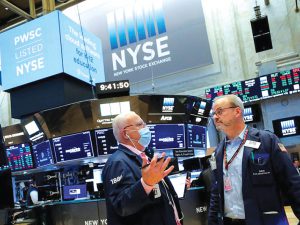BLOOMBERG
Stock markets worldwide extended losses on Thursday, as US 10-year Treasury bonds topped 4% for the first time since November in a sign that the Federal Reserve’s warnings of higher-for-longer interest rates are finally sinking in.
Europe’s Stoxx 600 equity index retreated 0.5%, having fallen to three-week lows as hotter-than-forecast German inflation data pushed money markets to bet on further interest rate rises from the European Central Bank. Markets are now bracing for the release of bloc-wide figures later in the day. US equity futures also fell, with contracts on the rate-sensitive Nasdaq down about 1% after both it and the S&P 500 index ended February with losses. In Asia, Hong Kong stocks slid as much as 1.5%
The focus now is on how much higher interest rates might go in the US and euro zone, with swaps markets now pricing a peak Fed policy rate of 5.5% in September, and some even betting on 6%. US 10-year yields, the main reference rate for the global cost of capital, rose 40 basis points in February and are consolidating their rise past 4%. ECB interest rates are now seen rising above 4%.
Such bets have been encouraged this week by a series of hot inflation readings across Europe, alongside a surge in a US manufacturing prices gauge. Fed officials, meanwhile, have continued to reinforce their hawkish stance — Atlanta Fed President Raphael Bostic on Wednesday urged continued rate hikes to above 5% to make sure inflation doesn’t pick up again, while the Minneapolis Fed’s Neel Kashkari said he was concerned there wasn’t much sign that rate hikes are slowing the services sector.
That’s damping appetite for risk taking in markets around the world, with some even expressing concern that China’s post-Covid economic recovery could exacerbate global price pressures.
China’s reopening is a much-needed bright spot for investors, but in terms of inflation “adds cyclical upside pressure because of the sheer amount of demand†that it brings, especially in commodities, Charu Chanana, senior markets strategist at Saxo Capital Markets, said on Bloomberg Television.
The hawkish Fed rate bets supported the US dollar against its Group-of-10 counterparts, with the greenback looking set to extend February’s 2.6% gain. The currencies of raw materials and energy exporters such as Australia, New Zealand and Norway slipped the most while the euro and sterling lost about 0.4%.
 The Gulf Time Newspaper One of the finest business newspapers in the UAE brought to you by our professional writers and editors.
The Gulf Time Newspaper One of the finest business newspapers in the UAE brought to you by our professional writers and editors.
